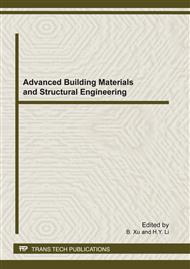[1]
S. M. Alamouti, A simple diversity techniques for wireless communications, IEEE J. Select. Areas commun., vol. 16, pp.1451-1458, Oct. (1998).
DOI: 10.1109/49.730453
Google Scholar
[2]
T. Yoo, A. Goldsmith, On the optimality of multi-antenna broadcast scheduling using zero-forcing beamforming, IEEE J. Sel. Areas Commun., vol. 24, no. 3, pp.528-541. May. (2006).
DOI: 10.1109/jsac.2005.862421
Google Scholar
[3]
M. Andrews, K. Kumaran, K. Ramannan, A. Stolyar, and P. Whiting, Prociding quality of service over a shared wireless link, IEEE Communications Magazine, vol. 39, no. 2 pp.150-154, Feb. (2001).
DOI: 10.1109/35.900644
Google Scholar
[4]
P. Viswanath, D. Tse, and R. Laroia, Opportunistic beamforming using dumb antennas, IEEE trans. Inf. Theory, vol. 48, no. 6, pp.1277-1294. May. (2002).
DOI: 10.1109/tit.2002.1003822
Google Scholar
[5]
H. Weingarten, Y. Steinberg, and S. Shamai, The capacity region of the Gaussian multiple-input multiple-output broadcast channel, IEEE trans. Inf. Theory, vol. 52, no. 9, pp.3936-3964. Sep. (2006).
DOI: 10.1109/tit.2006.880064
Google Scholar
[6]
E. M. Yeh, A. S. Cohen, information theory, queueing, and resource allocation in multi-user fading communications, in Proc. of the 2004 CISS, Princeton, NJ, Mar. (2004).
Google Scholar
[7]
L. Tassiulas and A. Ephremides, Stability properties of constrained queueing systems and scheduling policies for maximum throughput in multihop radio networks, IEEE trans. Automat. Contr., vol. 37, no. 12, pp.1936-1948. Dec. (1992).
DOI: 10.1109/9.182479
Google Scholar
[8]
M. J. Neely, E. Modiano and C. E. Rohrs, Power allocation and Routing in multibeam Satellites with time-varying channels, IEEE/ACM Transaction on Networking, vol. 11, pp.138-152, Feb. (2003).
DOI: 10.1109/tnet.2002.808401
Google Scholar
[9]
G. Caire, S. Shamai, On the achievable throughput of a multiantenna Gaussian broadcast channel, IEEE trans. Inf. Theory., vol. 49, no. 7, pp.1691-1706. Jul. (2003).
DOI: 10.1109/tit.2003.813523
Google Scholar
[10]
H. Vishwanathan and K. Kumaran, Rate scheduling in multiple antenna downlink wireless systems, IEEE trans. Commun., vol. 53, no. 4, pp.645-655. Apr. (2005).
DOI: 10.1109/tcomm.2005.844961
Google Scholar
[11]
M. Airy, S. Shakkottai, and J. R.W. Heath, Limiting queuing models for scheduling in multi-user mimo wireless systems, in Proc. of the 2nd IASTED Conf. on Communications, Internet & Info Technology, Scottsdale, Arizona, Nov. (2003).
Google Scholar
[12]
G. Dimi, N. D. Sidiropoulos, On downlink beamforming with greedy user selection: Performance analysis and a simple new algorithm, IEEE trans. Signal. Processing, vol. 53, no. 10, pp.3857-3868. Oct. (2005).
DOI: 10.1109/tsp.2005.855401
Google Scholar


